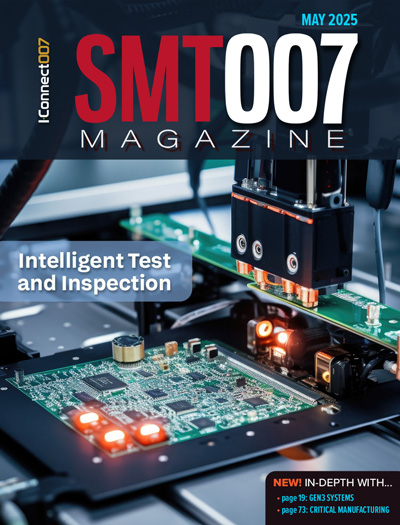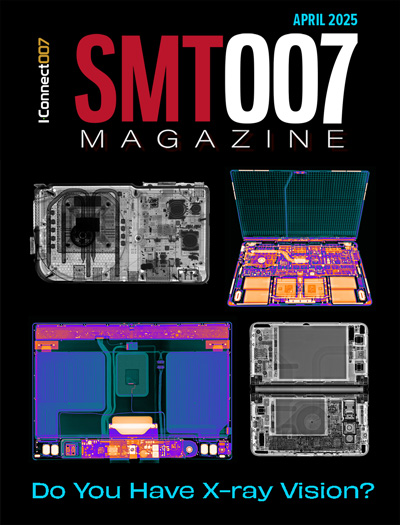-

- News
- Books
Featured Books
- smt007 Magazine
Latest Issues
Current Issue
Intelligent Test and Inspection
Are you ready to explore the cutting-edge advancements shaping the electronics manufacturing industry? The May 2025 issue of SMT007 Magazine is packed with insights, innovations, and expert perspectives that you won’t want to miss.

Do You Have X-ray Vision?
Has X-ray’s time finally come in electronics manufacturing? Join us in this issue of SMT007 Magazine, where we answer this question and others to bring more efficiency to your bottom line.

IPC APEX EXPO 2025: A Preview
It’s that time again. If you’re going to Anaheim for IPC APEX EXPO 2025, we’ll see you there. In the meantime, consider this issue of SMT007 Magazine to be your golden ticket to planning the show.
- Articles
- Columns
Search Console
- Links
- Media kit
||| MENU - smt007 Magazine
In-Circuit Pin Testing: An Excellent Potential Source of Value Creation
June 17, 2015 | Mitch Holtzer, AlphaEstimated reading time: 2 minutes
In-circuit pin testing (ICT) is a common method of inspecting electronic assemblies to measure the effectiveness of the assembly process and to predict electrical functionality. Test probes are put in contact with dedicated test points along the surface of an assembly, checking for electrical functions such as resistance, capacitance inductance and signal timing. Some circuit assemblers use functional testing for quality assurance as a substitute for ICT. In this example, the entire assembly either works or it doesn’t.
Unlike printing paste, placing components and reflowing solder, ICT is considered a non-value added process. In fact, ICT increases the cycle time of the assembly process. If the ICT is a fail, but the circuit being tested is actually good (known as a false negative), even more time is wasted trying to determine whether or not a good assembly will function properly.
The two basic types of ICT are commonly referred to as clamshell and flying probe. The clamshell ICT simultaneously tests dozens of points on a single board. One laboratory type of clamshell ICT device uses three types of pins and four different forces. A test vehicle is placed in the clamshell fixture. The clamshell is closed, and electrical resistivity is measured at each of the test pins.
Although clamshell devices are commonly used, they are somewhat impractical for testing solder paste and flux’s ability to be probed. Typically, there can be a 15-minute cycle time per test. Pin residue build up generally occurs after hundreds of tests. Cleaning flux build-up from pins is time-consuming, but necessary to minimize false negative readings.
Clamshell fixtures are quite expensive. A customized fixture must be fabricated for each unique assembly. This cost is only justified for the testing of high-value or high-volume assemblies.
Flying probe testing is also commonly used for lower value or lower volume assemblies. Flying probes test sequences are determined by easily changeable programming inputs. Clamshell fixtures are not required. Therefore, this type of test method is more suited for high mix circuit assembly applications.
In a common laboratory flying probe procedure, one pin type and one force are used, but the test runs for a total of 4,000 strikes. Flux build-up on the pins is an important part of the test. In addition, one common laboratory test vehicle contains four different types of pads. In this example, pad A is a 40 mil (1mm) square pad without vias, pad B is a 40 mil (1mm) square pad with 13 mil (0.33mm) vias, pad C is a 28 mil (0.7mm) round pad without vias, and pad D is a 28 mil (0.77mm) round pad with 13 mil (0.33mm) vias. There are 1,000 opportunities for each pad type.
Read The Full Article Here
Editor's Note: This article originally appeared in the June 2015 issue of SMT Magazine.
Suggested Items
See TopLine’s Next Gen Braided Solder Column Technology at SPACE TECH EXPO 2025
05/28/2025 | TopLineAerospace and Defense applications in demanding environments have a solution now in TopLine’s Braided Solder Columns, which can withstand the rigors of deep space cold and cryogenic environments.
INEMI Interim Report: Interconnection Modeling and Simulation Results for Low-Temp Materials in First-Level Interconnect
05/30/2025 | iNEMIOne of the greatest challenges of integrating different types of silicon, memory, and other extended processing units (XPUs) in a single package is in attaching these various types of chips in a reliable way.
E-tronix Announces Upcoming Webinar with ELMOTEC: Optimizing Soldering Quality and Efficiency with Robotic Automation
05/30/2025 | E-tronixE-tronix, a Stromberg Company, is excited to host an informative webinar presented by Raphael Luchs, CEO of ELMOTEC, titled "Optimize Soldering Quality and Efficiency with Robotic Automation," taking place on Wednesday, June 4, 2025 at 12:00 PM CDT.
CE3S Launches EcoClaim Solutions to Simplify Recycling and Promote Sustainable Manufacturing
05/29/2025 | CE3SCumberland Electronics Strategic Supply Solutions (CE3S), your strategic sourcing, professional solutions and distribution partner, is proud to announce the official launch of EcoClaim™ Solutions, a comprehensive recycling program designed to make responsible disposal of materials easier, more efficient, and more accessible for manufacturers.
Indium to Feature Precision Gold-Based Die-Attach Preforms at IMS 2025
05/29/2025 | Indium CorporationIndium Corporation® will feature its high-reliability, gold-based precision die-attach preforms for critical laser and RF applications, as well as 5G communications, at the International Microwave Symposium, June 15-19, in San Francisco, CA.


